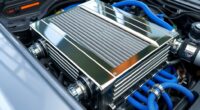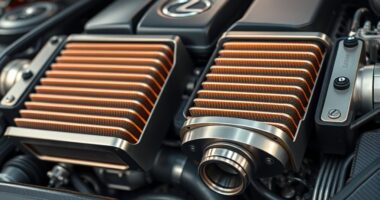To boost your Lexus LC or IS F’s braking performance, upgrade to larger, lightweight rotors with multi-piston calipers like Brembo or Wilwood, which improve heat dissipation, response, and fade resistance. Choose high-performance pads designed for reduced dust and noise, complemented by stainless steel lines for better pedal feel. Proper cooling and heat-resistant components guarantee reliable stopping power during spirited drives or track days. Keep exploring for more tips to maximize your brake upgrade.
Key Takeaways
- Upgrade to 15-inch lightweight, two-piece rotors with corrosion-resistant coatings for improved heat dissipation and durability.
- Pair larger rotors with multi-piston calipers like Brembo or Wilwood for enhanced braking response and fade resistance.
- Use high-performance brake pads such as Project Mu Type NS-C or TOMS Performer 600C for strong stopping power and reduced dust.
- Incorporate larger calipers and rotors to increase brake surface area, boosting stopping power and heat management.
- Enhance thermal management with vented rotors, high-temp brake fluids, and steel lines for consistent performance during track or daily driving.
Upgrading to High-Performance Brake Rotors for Lexus LC and IS F

Upgrading to high-performance brake rotors for your Lexus LC or IS F can markedly improve stopping power and reliability during spirited driving. These high-performance brake rotors are larger, lightweight, two-piece units with increased thermal capacity, typically measuring 15 inches in diameter. Made from high-quality cast iron with stainless steel finishes and corrosion-resistant coatings, they withstand extreme conditions. Pairing these rotors with multi-piston calipers, like RCF Brembo or Wilwood Forged Superlight models, boosts braking response and fade resistance. The installation includes CNC-milled aluminum brackets and longer bolts for precise fitment and optimized brake bias. This brake upgrade reduces rotor weight by about 17 pounds per pair, enhancing overall braking performance, especially during aggressive driving or track use. Additionally, understanding the importance of thermal capacity helps in selecting rotors that maintain performance under high-stress conditions. Incorporating proper ventilation in the rotor design further aids in heat dissipation, ensuring consistent braking during extended use. Recognizing the role of dynamic cooling techniques can further improve rotor longevity and performance during high-demand driving scenarios. Moreover, selecting rotors with advanced ventilation designs can significantly enhance heat dissipation and overall brake efficiency. Furthermore, considering brake pad compatibility ensures optimal interaction between components for maximum stopping power.
Choosing the Right Brake Pads for Enhanced Stopping Power
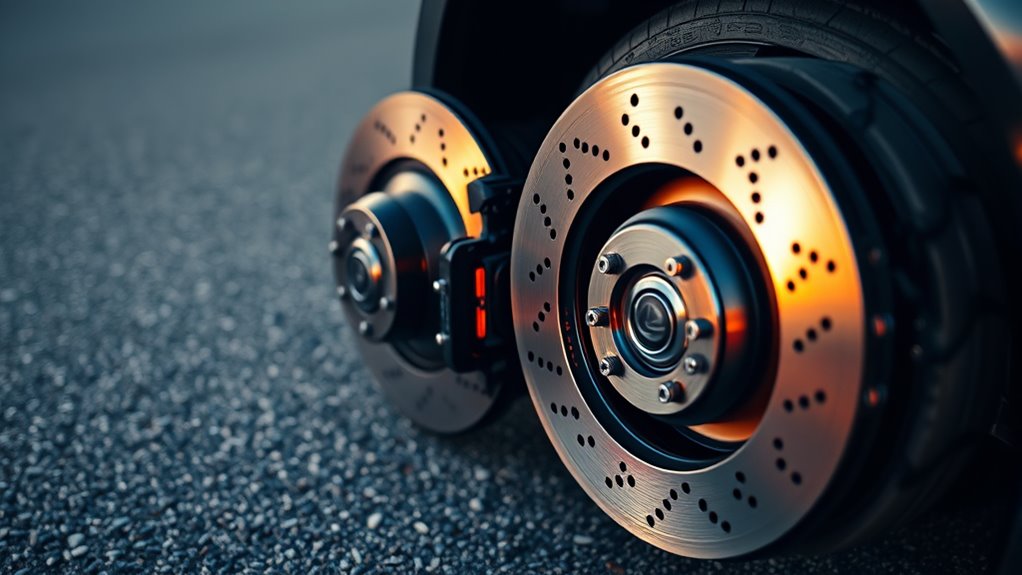
Choosing the right brake pads can make a big difference in your driving experience, especially when it comes to dust and noise levels. High-performance options like Project Mu Type NS-C, Type PS, and TOMS Racing Performer 600C are designed to provide strong stopping power while minimizing dust and noise during daily use. By selecting pads suited to your driving style, you guarantee reliable performance and comfort on every ride. Proper application methods and regular maintenance also play a crucial role in ensuring optimal brake performance and longevity. Additionally, selecting pads with appropriate friction levels ensures a balanced combination of stopping power and reduced wear on your rotors. Embracing the concept of creative practice can even inspire innovative ways to improve your vehicle’s braking system, such as exploring custom modifications or integrating new technologies.
Dust and Noise Control
Selecting the right brake pads can make a significant difference in reducing dust and noise during your drives. High-quality performance pads like Project Mu Type NS-C and TOMS Racing Performer 600C are designed to minimize brake dust and noise compared to OEM options. These pads use advanced friction materials that provide consistent braking while controlling dust buildup, keeping your wheels cleaner longer. Noise reduction features such as metal shims and optimized pad shapes help ensure quieter braking experiences, especially during daily driving. Choosing pads with high heat resistance and high friction levels guarantees reliable stopping power, even during spirited driving, without sacrificing dust control or creating excessive noise. Proper brake pad selection is essential for Ford Tuning enthusiasts seeking to optimize performance while maintaining cleanliness and comfort. With the right performance pads, you’ll enjoy improved cleanliness and a quieter ride. Additionally, selecting pads with dust control properties can further enhance your vehicle’s appearance and reduce maintenance efforts. Understanding the dust and noise characteristics of different brake pads helps ensure a smoother and more enjoyable driving experience. Being aware of environmental considerations, such as dust generation, can help you choose pads that are both effective and eco-friendly. Incorporating brake pad materials into your selection process can also influence dust and noise levels, leading to better overall performance.
Performance Under Daily Use
For daily driving, the right brake pads can substantially enhance your stopping power without sacrificing comfort or reliability. High-quality brake pads like Project Mu Type NS-C, PS, and TOMS Racing Performer 600C are designed to improve stopping performance while reducing brake dust and noise. These pads deliver consistent performance under regular conditions, boosting safety and confidence during everyday stops. Pairing them with stainless steel brake lines can further improve brake response and pedal feel. A proper brake upgrade guarantees your Lexus LC or IS F maintains excellent fade resistance and durability through city traffic and highway miles. Choosing the right brake pads means better responsiveness and longer-lasting brakes, making your daily drives safer and more enjoyable without compromising comfort.
Benefits of Larger Calipers and Rotors in Brake System Performance

Upgrading to larger calipers and rotors boosts your brake system’s ability to dissipate heat, preventing brake fade during intense driving. This improvement also increases your stopping power and ensures consistent performance under demanding conditions. Together, these enhancements give you more reliable, responsive braking when it matters most. Additionally, brake safety standards emphasize the importance of such upgrades to maintain optimal vehicle control. Implementing these upgrades can also help your vehicle better adhere to performance requirements set by manufacturers and regulatory bodies. Moreover, adopting these enhancements supports adherence to quality assurance protocols that ensure safety and reliability in high-performance braking systems. Properly installed, larger calipers and rotors can also contribute to longer component lifespan, reducing the need for frequent replacements and maintenance.
Enhanced Heat Dissipation
Larger calipers and rotors considerably enhance heat dissipation within the brake system, especially during aggressive driving. This improvement helps keep brake temperatures in check, reducing brake fade and maintaining consistent performance. Upgrading to larger components offers several benefits:
- The increased surface area aids in faster heat transfer away from the caliper and rotor surfaces.
- Thick 15-inch Girodisc rotors absorb and disperse heat more effectively, preventing overheating.
- Lightweight RCF 2-piece rotors minimize heat transfer to other brake parts, like steel brake lines and the rear caliper.
- Larger calipers support bigger brake pads, which distribute heat evenly and improve cooling at high temperatures.
- Advances in thermal management techniques in brake design further enhance cooling efficiency.
Altogether, these enhancements extend the lifespan of your brake pads and rotors, ensuring reliable performance under extreme conditions.
Increased Stopping Power
Expanding the size of your calipers and rotors directly boosts your brake system’s stopping power by increasing the surface area available for friction. Upgrading to a Big Brake setup, such as a Superlite Caliper Rear Brake, enhances your vehicle’s ability to generate greater stopping force. Larger rotors, often 15 inches in diameter, improve thermal capacity, reducing brake fade during aggressive driving or track use. Bigger calipers allow for larger brake pads, which dissipate heat more effectively and increase braking force. This upgrade for Lexus models improves brake bias, ensuring balanced stopping performance. The added rotor mass and larger calipers contribute to higher torque, providing more consistent and powerful braking, even under demanding conditions. Additionally, brake system enhancements can also improve pedal feel and modulation, giving the driver better control. Incorporating thermal management techniques further helps maintain optimal brake performance during intense use. Proper selection of brake components ensures compatibility and optimal performance, maximizing the benefits of these upgrades. Moreover, utilizing advanced materials in brake parts can reduce weight while maintaining strength, further improving overall vehicle responsiveness. Implementing proper installation techniques is essential to ensure safety and effectiveness of the upgraded brake system. Overall, these enhancements deliver a significant increase in stopping power for your Lexus.
Reduced Brake Fade
When your brake components are larger and have greater thermal capacity, they can better handle the heat generated during aggressive driving. Upgrading to bigger calipers and 15-inch rotors reduces brake fade by maintaining consistent clamping force even under high temperatures. This means:
- Steel brake lines improve fluid response, preventing brake fade during racing or spirited driving.
- Larger rotors absorb heat more efficiently, reducing the risk of brake fluid boiling.
- Caliper rear brake upgrades enhance heat dissipation, sustaining braking performance.
- The increased surface area of larger pads and rotors ensures consistent stopping power during prolonged stops.
- The compatibility of your brake components influences how effectively they perform under varying conditions, especially in high-performance scenarios.
Together, these upgrades help your Lexus maintain reliable performance, especially during track days or aggressive driving sessions, keeping you safe and in control.
The Importance of Proper Brake Cooling and Heat Resistance

Proper brake cooling is essential to maintaining peak stopping performance, especially during high-speed or aggressive driving. Without adequate airflow, heat builds up, causing brake fade and diminishing your stopping power. Heat-resistant brake components, like upgraded rotors and calipers, withstand temperatures over 1,000°F, ensuring structural integrity under stress. Efficient ventilation and aerodynamic features promote effective heat dissipation, preventing issues like brake fluid boiling and increased pedal travel. Neglecting cooling can lead to warping, cracking, and pad glazing, shortening component lifespan. To better understand, consider this:
| Brake Cooling Strategies | Benefits |
|---|---|
| Vented rotors and aerodynamic design | Enhance airflow, reduce heat buildup |
| High-temperature brake components | Resist thermal stress, prolong life |
| Proper ventilation system | Prevent brake fade, maintain responsiveness |
Installing Lightweight Rotors and Calipers for Improved Responsiveness
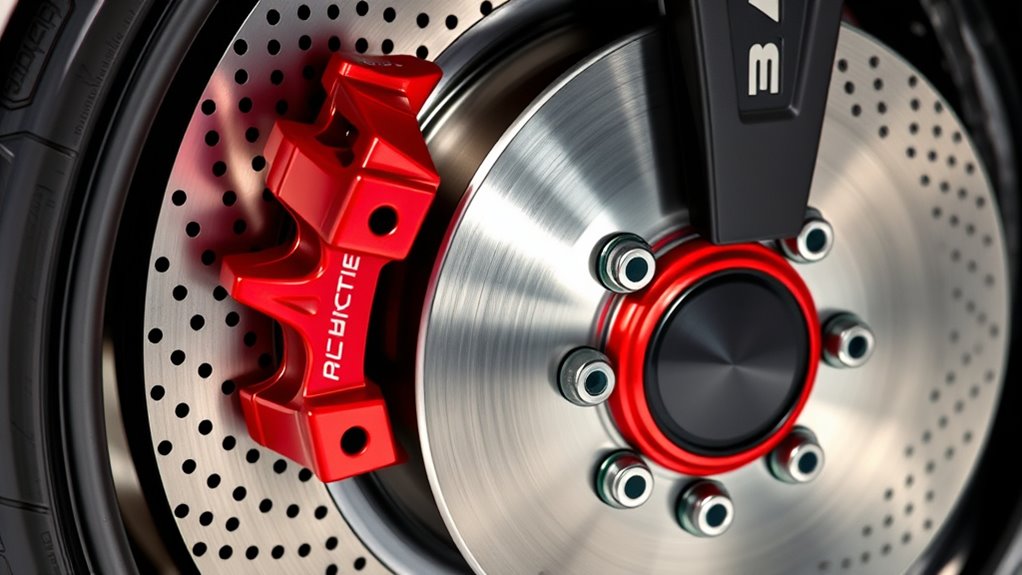
Installing lightweight rotors and calipers can substantially boost your Lexus LC or IS F’s responsiveness by reducing unsprung mass and rotational inertia. This upgrade enhances brake responsiveness, making your vehicle more agile and responsive during aggressive driving. Consider these key benefits:
- Lightweight Rotors, like Girodisc 2-piece rotors, cut unsprung weight by about 17.4 lbs per pair, improving handling.
- Upgrading to RCF Brembo calipers allows for larger brake pads—around 30% bigger—enhancing brake modulation and fade resistance.
- Lightweight calipers made from aerospace-grade billet aluminum decrease rotational inertia, resulting in quicker pedal response.
- Larger, high-performance rotors with increased thermal capacity maintain consistent braking under demanding conditions.
Together, these upgrades optimize brake system weight distribution, delivering more immediate, precise stopping power.
Enhancing Brake System Durability for Track and Daily Use

Upgrading your brake system with larger, lightweight rotors and multi-piston calipers dramatically boosts durability for both track days and daily driving. A Track-Ready Brake Kit often includes high-performance brake rotors, which efficiently dissipate heat and resist warping, ensuring consistent braking. Pairing these with forged Superlite calipers enhances strength while reducing weight, contributing to longer system life. Steel brake lines improve hydraulic response and pedal feel under intense conditions, preventing expansion and maintaining brake performance. Using high-temp brake fluids further protects your system during prolonged or aggressive stops. These upgrades collectively resist cracking, warping, and corrosion, extending service intervals and ensuring reliable braking whether on the track or navigating daily commutes.
Tips for Proper Bed-In and Maintenance of Upgraded Brakes
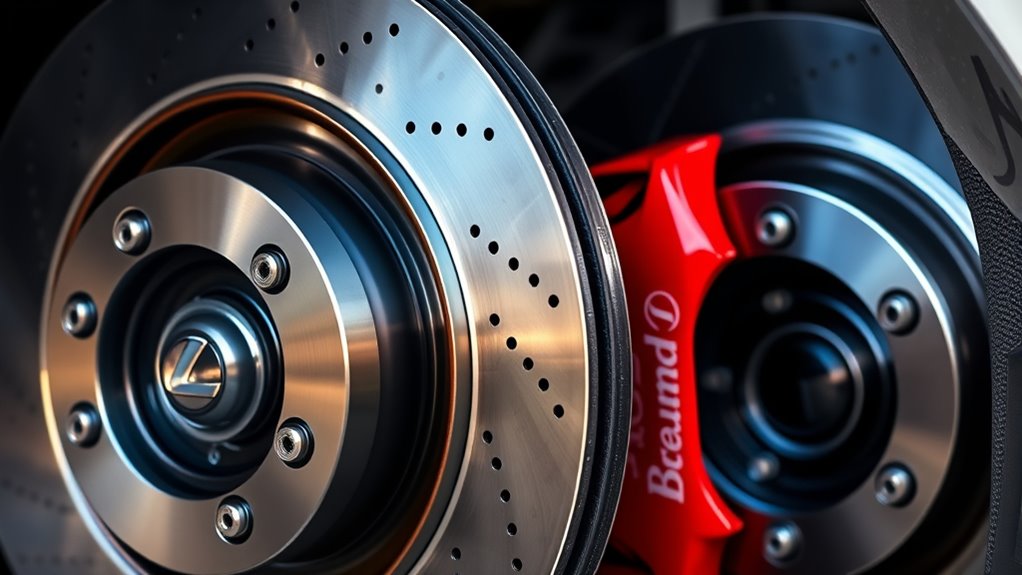
Once you’ve installed your upgraded brake components, following the correct bed-in procedure is key to maximizing their performance and longevity. Proper brake bed-in guarantees an even transfer layer between brake pads and rotors, reducing brake fade. Here’s what you should do:
Proper brake bed-in maximizes performance and extends rotor and pad life.
- Perform multiple moderate stops from 50-60 mph, gradually heating the brake rotors.
- Avoid hard braking or coming to a complete stop immediately after driving to prevent glazing.
- Allow the brakes to cool between stops to prevent excessive heat buildup.
- After completing the process, inspect and clean the brake rotors and pads to spot uneven wear or debris.
Following these brake bed-in tips and maintaining your brakes regularly will ensure consistent braking performance and extend the life of your brake rotors and pads.
Frequently Asked Questions
How Long Do Lexus Brake Rotors Last?
Your Lexus brake rotors typically last between 30,000 and 70,000 miles, depending on your driving habits and conditions. If you drive aggressively or in hilly areas, expect a shorter lifespan. Regular inspections for grooves, cracks, or vibrations help catch wear early. Upgrading to high-performance rotors or maintaining proper care with coatings can extend their life, so stay attentive to signs of wear to make certain of safe braking.
How Long Do Lexus Calipers Last?
Think of your calipers as the steady guardians of your braking system, lasting between 75,000 to 100,000 miles with proper care. You’ll want to watch for signs like sticking, corrosion, or uneven wear, which signal they’re nearing the end of their lifespan. Aggressive driving or harsh environments can cut this time short. Regular inspections and maintenance guarantee your calipers stay reliable, keeping your driving safe and smooth.
How Often Should Lexus Brakes Be Replaced?
You should replace your Lexus brakes every 20,000 to 50,000 miles, depending on your driving habits. Regular inspections are essential, especially for brake pads and rotors, which may need replacement sooner if you drive aggressively or tow often. Keep up with brake fluid changes every 2 to 3 years to guarantee peak performance. Monitoring brake condition helps you avoid unexpected failures and keeps your vehicle safe.
What Are Upgraded Brakes?
Imagine your car’s brakes as the heart of your driving experience, delivering essential stops at a moment’s notice. Upgraded brakes are high-performance parts like larger calipers and rotors that boost your stopping power. They use lightweight materials and advanced designs, such as drilled or slotted rotors, to prevent fade and improve response. These enhancements give you confidence, safety, and control, especially during spirited driving or on the track.
Conclusion
Upgrading your Lexus LC or IS F brakes can boost stopping power by up to 30%, making every drive safer and more responsive. With the right combination of high-performance rotors, pads, and cooling, you’ll experience better durability and heat resistance, whether on the street or track. Proper maintenance ensures your upgrades last longer—so don’t skip the bed-in process! Remember, investing in quality brakes can reduce stopping distances considerably, giving you peace of mind on every ride.

